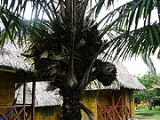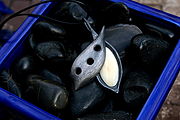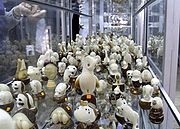
Phytelephas
Encyclopedia
Phytelephas is a genus
containing six species
of palms
(family
Arecaceae), occurring from southern Panama
along the Andes
to Ecuador
, Bolivia
and Peru
. They are commonly known as ivory palms, ivory-nut palms or tagua palms; their scientific name means "plant elephant
". This and the first two of the common names refer to the very hard white endosperm
of their seeds (tagua nuts), which resembles elephant ivory
.
They are medium-sized to tall palms reaching up to 20 m tall, with pinnate leaves
. In its original state, the "nut" is covered with pericarp, which gets removed by various animals. The kernel is covered with a brown, flaky skin and shaped like a small avocado
, roughly 4-8 cm in diameter.

 Given trade restrictions in elephant
Given trade restrictions in elephant
ivory as well as animal welfare
concerns, ivory palm endosperm is often used as a substitute for elephant ivory today, and traded as vegetable ivory, palm ivory, corozo or tagua. When dried out, it can be carved just like elephant ivory; it is often used for beads, buttons, figurines and jewelry, and can be dyed. More recently, palm ivory has been used in the production of bagpipes
. Vegetable ivory furthers important environmental and socioeconomic goals by stimulating the local economies and microenterprises in South America, provides an alternative to cutting down rainforest
s for farming, and prevents elephants from being killed for the ivory in their tusks.
In Ecuador
, the Ecuadorean Ivory Palm (P. aequatorialis) is the species
whose kernels are widely harvested. The Large-fruited Ivory Palm (P. macrocarpa) is the ivory palm native to Brazil, and most internationally-traded palm ivory is derived from this species. The Colombian Ivory Palm (P. schottii) and P. tenuicaulis, both formerly included in P. macrocarpa, are the usual source of the product in Colombia
. The other two species are quite rare and have a restricted range; they are not used for tagua production on a significant scale.
The kernels are typically simply picked up from the ground after the ripe fruit has detached from the tree and forest animals have taken care of the pericarp, or harvested when ripe and the pericarp manually removed. As the nut shrinks when it hardens a small hollow cavity can form in the centre. It is often not possible to know whether the inside of the nut will have a small cavity in the centre until it is cut into. Therefore, when carving, it is common to either incorporate the hole or cavity into carvings or not carve deep enough to reach a potential cavity.
In their native range, these palms are also used as a source of food and construction wood.
Genus
In biology, a genus is a low-level taxonomic rank used in the biological classification of living and fossil organisms, which is an example of definition by genus and differentia...
containing six species
Species
In biology, a species is one of the basic units of biological classification and a taxonomic rank. A species is often defined as a group of organisms capable of interbreeding and producing fertile offspring. While in many cases this definition is adequate, more precise or differing measures are...
of palms
Arecaceae
Arecaceae or Palmae , are a family of flowering plants, the only family in the monocot order Arecales. There are roughly 202 currently known genera with around 2600 species, most of which are restricted to tropical, subtropical, and warm temperate climates...
(family
Family (biology)
In biological classification, family is* a taxonomic rank. Other well-known ranks are life, domain, kingdom, phylum, class, order, genus, and species, with family fitting between order and genus. As for the other well-known ranks, there is the option of an immediately lower rank, indicated by the...
Arecaceae), occurring from southern Panama
Panama
Panama , officially the Republic of Panama , is the southernmost country of Central America. Situated on the isthmus connecting North and South America, it is bordered by Costa Rica to the northwest, Colombia to the southeast, the Caribbean Sea to the north and the Pacific Ocean to the south. The...
along the Andes
Andes
The Andes is the world's longest continental mountain range. It is a continual range of highlands along the western coast of South America. This range is about long, about to wide , and of an average height of about .Along its length, the Andes is split into several ranges, which are separated...
to Ecuador
Ecuador
Ecuador , officially the Republic of Ecuador is a representative democratic republic in South America, bordered by Colombia on the north, Peru on the east and south, and by the Pacific Ocean to the west. It is one of only two countries in South America, along with Chile, that do not have a border...
, Bolivia
Bolivia
Bolivia officially known as Plurinational State of Bolivia , is a landlocked country in central South America. It is the poorest country in South America...
and Peru
Peru
Peru , officially the Republic of Peru , is a country in western South America. It is bordered on the north by Ecuador and Colombia, on the east by Brazil, on the southeast by Bolivia, on the south by Chile, and on the west by the Pacific Ocean....
. They are commonly known as ivory palms, ivory-nut palms or tagua palms; their scientific name means "plant elephant
Elephant
Elephants are large land mammals in two extant genera of the family Elephantidae: Elephas and Loxodonta, with the third genus Mammuthus extinct...
". This and the first two of the common names refer to the very hard white endosperm
Endosperm
Endosperm is the tissue produced inside the seeds of most flowering plants around the time of fertilization. It surrounds the embryo and provides nutrition in the form of starch, though it can also contain oils and protein. This makes endosperm an important source of nutrition in human diet...
of their seeds (tagua nuts), which resembles elephant ivory
Ivory
Ivory is a term for dentine, which constitutes the bulk of the teeth and tusks of animals, when used as a material for art or manufacturing. Ivory has been important since ancient times for making a range of items, from ivory carvings to false teeth, fans, dominoes, joint tubes, piano keys and...
.
They are medium-sized to tall palms reaching up to 20 m tall, with pinnate leaves
Leaf
A leaf is an organ of a vascular plant, as defined in botanical terms, and in particular in plant morphology. Foliage is a mass noun that refers to leaves as a feature of plants....
. In its original state, the "nut" is covered with pericarp, which gets removed by various animals. The kernel is covered with a brown, flaky skin and shaped like a small avocado
Avocado
The avocado is a tree native to Central Mexico, classified in the flowering plant family Lauraceae along with cinnamon, camphor and bay laurel...
, roughly 4-8 cm in diameter.
Uses


Elephant
Elephants are large land mammals in two extant genera of the family Elephantidae: Elephas and Loxodonta, with the third genus Mammuthus extinct...
ivory as well as animal welfare
Animal welfare
Animal welfare is the physical and psychological well-being of animals.The term animal welfare can also mean human concern for animal welfare or a position in a debate on animal ethics and animal rights...
concerns, ivory palm endosperm is often used as a substitute for elephant ivory today, and traded as vegetable ivory, palm ivory, corozo or tagua. When dried out, it can be carved just like elephant ivory; it is often used for beads, buttons, figurines and jewelry, and can be dyed. More recently, palm ivory has been used in the production of bagpipes
Bagpipes
Bagpipes are a class of musical instrument, aerophones, using enclosed reeds fed from a constant reservoir of air in the form of a bag. Though the Scottish Great Highland Bagpipe and Irish uilleann pipes have the greatest international visibility, bagpipes of many different types come from...
. Vegetable ivory furthers important environmental and socioeconomic goals by stimulating the local economies and microenterprises in South America, provides an alternative to cutting down rainforest
Rainforest
Rainforests are forests characterized by high rainfall, with definitions based on a minimum normal annual rainfall of 1750-2000 mm...
s for farming, and prevents elephants from being killed for the ivory in their tusks.
In Ecuador
Ecuador
Ecuador , officially the Republic of Ecuador is a representative democratic republic in South America, bordered by Colombia on the north, Peru on the east and south, and by the Pacific Ocean to the west. It is one of only two countries in South America, along with Chile, that do not have a border...
, the Ecuadorean Ivory Palm (P. aequatorialis) is the species
Species
In biology, a species is one of the basic units of biological classification and a taxonomic rank. A species is often defined as a group of organisms capable of interbreeding and producing fertile offspring. While in many cases this definition is adequate, more precise or differing measures are...
whose kernels are widely harvested. The Large-fruited Ivory Palm (P. macrocarpa) is the ivory palm native to Brazil, and most internationally-traded palm ivory is derived from this species. The Colombian Ivory Palm (P. schottii) and P. tenuicaulis, both formerly included in P. macrocarpa, are the usual source of the product in Colombia
Colombia
Colombia, officially the Republic of Colombia , is a unitary constitutional republic comprising thirty-two departments. The country is located in northwestern South America, bordered to the east by Venezuela and Brazil; to the south by Ecuador and Peru; to the north by the Caribbean Sea; to the...
. The other two species are quite rare and have a restricted range; they are not used for tagua production on a significant scale.
The kernels are typically simply picked up from the ground after the ripe fruit has detached from the tree and forest animals have taken care of the pericarp, or harvested when ripe and the pericarp manually removed. As the nut shrinks when it hardens a small hollow cavity can form in the centre. It is often not possible to know whether the inside of the nut will have a small cavity in the centre until it is cut into. Therefore, when carving, it is common to either incorporate the hole or cavity into carvings or not carve deep enough to reach a potential cavity.
In their native range, these palms are also used as a source of food and construction wood.
List of species
As of 2004, the following species were considered valid:- Phytelephas aequatorialisPhytelephas aequatorialisThe palm tree Phytelephas aequatorialis, commonly known as Ecuadorean Ivory Palm, is the main source of Ecuadorean vegetable ivory or tagua, a botanical alternative to ivory. This palm is found in the tropical rainforests of Ecuador...
– Ecuadorean Ivory Palm - Phytelephas macrocarpa Ruiz & Pav. – Large-fruited Ivory Palm
- Phytelephas schottii H.Wendl. – Colombian Ivory Palm (formerly considered a subspeciesSubspeciesSubspecies in biological classification, is either a taxonomic rank subordinate to species, ora taxonomic unit in that rank . A subspecies cannot be recognized in isolation: a species will either be recognized as having no subspecies at all or two or more, never just one...
of P. macrocarpa) - Phytelephas seemanniiPhytelephas seemanniiPhytelephas seemannii is a species of flowering plant in the Arecaceae family.It is found in Colombia and Panama.-Source:* Bernal, R. 1998. . Downloaded on 20 July 2007....
- Phytelephas tenuicaulis (Barfod) A.J.Hend. (formerly considered a subspecies of P. macrocarpa)
- Phytelephas tumacanaPhytelephas tumacanaPhytelephas tumacana is a species of flowering plant in the Arecaceae family.It is found only in Colombia.Phytelephas tumacana is an endangered species of flowering palm tree in the Arecaceae family. Its cold hardiness zone is 11.-Source:...
External links
- Site Dedicated to Tagua
- Tagua Information About Tagua
- Vegetable Ivory: Saving Elephants & The Rain Forest
- The New Student's Reference Work/Ivory, Vegetable

